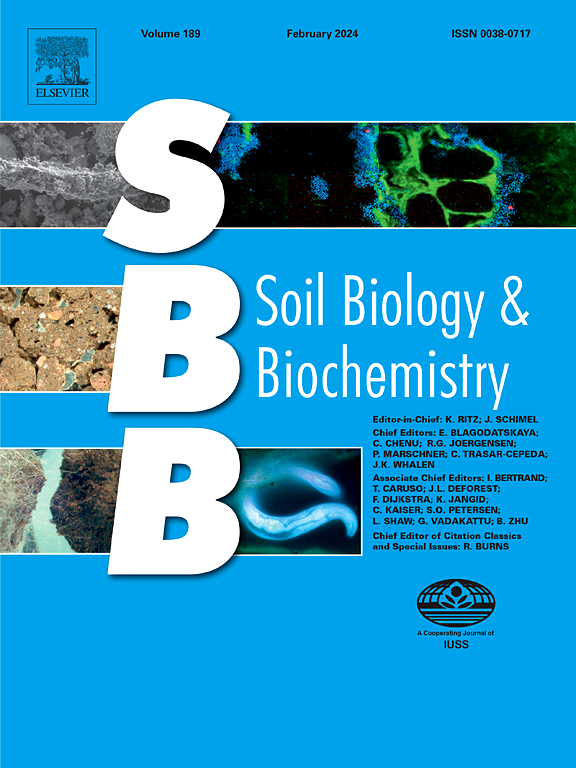Soil aggregates stability is evidently enhanced by super-binding of the N-terminal disordered tail of glomalin to soil minerals
IF 10.3
1区 农林科学
Q1 SOIL SCIENCE
引用次数: 0
Abstract
Glomalin-related soil protein (GRSP) extracted from soil is considered crucial for the formation and stability of soil aggregates. However, due to limitations in extraction purity and interference from co-extracted products, the actual contribution of pure glomalin produced by arbuscular mycorrhizal fungi (AMF) to soil structure improvement and its specific mechanism of action remain elusive. Here, genetic engineering and cryo-electron microscopy (cryo-EM) are introduced to obtain purified glomalin and to determine its homo-tetradecamer structure. This allowed investigations of the effect of pure glomalin on soil aggregate stability and the specific glomalin-mineral interaction mechanism. The results showed that addition of glomalin significantly enhanced the formation of soil water-stable aggregates and soil macroaggregates. This enhancement was primarily attributed to the strong binding of glomalin to soil minerals, as evidenced by single molecule force spectroscopy (SMFS) and attenuated total reflectance-Fourier transform infrared spectrum (ATR-FTIR) experiments. Glomalin structural analysis, comparison of its amino sequence alignment with that of Escherichia coli heat shock protein 60 (E. coli Hsp60) and mineral binding experiments with several glomalin related mutants highlighted that the N-terminus disordered tail of glomalin composed of ∼39 amino acids were crucial for the glomalin super binding ability. These findings advance the understanding of glomalin's intrinsic mechanism for improving soil structure and open the opportunity for mass production of this ecologically important protein as a soil amendment.


球蛋白n端无序尾与土壤矿物质的超结合明显增强了土壤团聚体的稳定性
从土壤中提取的Glomalin-related soil protein (GRSP)被认为对土壤团聚体的形成和稳定至关重要。然而,由于提取纯度的限制和共提取产物的干扰,丛枝菌根真菌(AMF)产生的纯球囊素对土壤结构改善的实际贡献及其具体作用机制尚不清楚。在这里,基因工程和冷冻电子显微镜(冷冻电镜)被引入获得纯化的肾小球素和确定其同质四聚体结构。这使得研究纯球囊素对土壤团聚体稳定性的影响以及球囊素-矿物质的具体相互作用机制成为可能。结果表明,添加球囊素显著促进了土壤水稳性团聚体和土壤大团聚体的形成。单分子力谱(SMFS)和衰减全反射-傅里叶变换红外光谱(ATR-FTIR)实验证明,这种增强主要归因于glomalin与土壤矿物质的强结合。对Glomalin的结构分析、与大肠杆菌热休克蛋白60 (E. coli Hsp60)的氨基酸序列比对以及与几种Glomalin相关突变体的矿物结合实验表明,由~ 39个氨基酸组成的n端紊乱尾部对Glomalin的超结合能力至关重要。这些发现促进了对球球蛋白改善土壤结构的内在机制的理解,并为这种生态上重要的蛋白质作为土壤改良剂的大规模生产提供了机会。
本文章由计算机程序翻译,如有差异,请以英文原文为准。
求助全文
约1分钟内获得全文
求助全文
来源期刊

Soil Biology & Biochemistry
农林科学-土壤科学
CiteScore
16.90
自引率
9.30%
发文量
312
审稿时长
49 days
期刊介绍:
Soil Biology & Biochemistry publishes original research articles of international significance focusing on biological processes in soil and their applications to soil and environmental quality. Major topics include the ecology and biochemical processes of soil organisms, their effects on the environment, and interactions with plants. The journal also welcomes state-of-the-art reviews and discussions on contemporary research in soil biology and biochemistry.
 求助内容:
求助内容: 应助结果提醒方式:
应助结果提醒方式:


